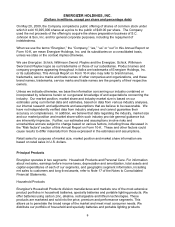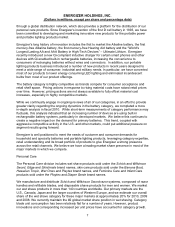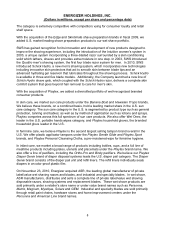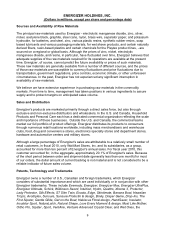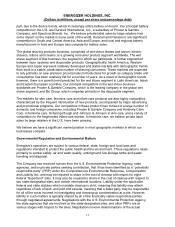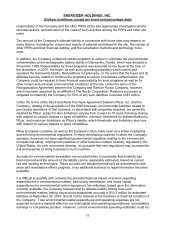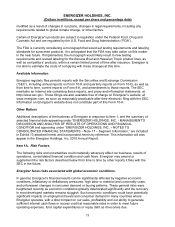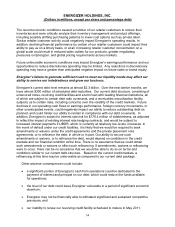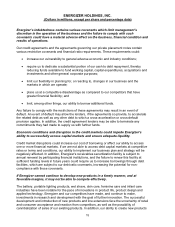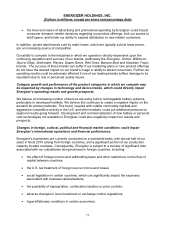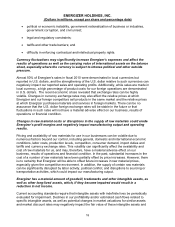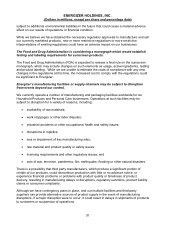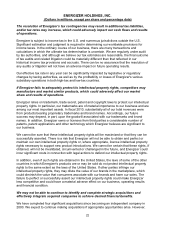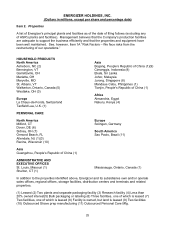Energizer 2010 Annual Report Download - page 25
Download and view the complete annual report
Please find page 25 of the 2010 Energizer annual report below. You can navigate through the pages in the report by either clicking on the pages listed below, or by using the keyword search tool below to find specific information within the annual report.
ENERGIZER HOLDINGS, INC.
(Dollars in millions, except per share and percentage data)
15
Energizer’s indebtedness contains various covenants which limit management’s
discretion in the operation of the business and the failure to comply with such
covenants could have a material adverse effect on the business, financial condition and
results of operations.
Our credit agreements and the agreements governing our private placement notes contain
various restrictive covenants and financial ratio requirements. These requirements could:
• increase our vulnerability to general adverse economic and industry conditions;
• require us to dedicate a substantial portion of our cash to debt repayment, thereby
reducing funds available to fund working capital, capital expenditures, acquisitions and
investments and other general corporate purposes;
• limit our flexibility in planning for, or reacting to, changes in our business and the
markets in which we operate;
• place us at a competitive disadvantage as compared to our competitors that have
greater financial flexibility; and
• limit, among other things, our ability to borrow additional funds.
Any failure to comply with the restrictions of these agreements may result in an event of
default. An event of default may allow the lenders, if the agreements so provide, to accelerate
the related debt as well as any other debt to which a cross-acceleration or cross-default
provision applies. In addition, the credit agreement lenders may be able to terminate any
commitments they had made to supply us with further funds.
Economic conditions and disruption in the credit markets could impede Energizer’s
ability to successfully access capital markets and ensure adequate liquidity.
Credit market disruptions could increase our cost of borrowing or affect our ability to access
one or more financial markets. If we are not able to access debt capital markets at competitive
rates or terms and conditions, our ability to implement our business plan and strategy will be
negatively affected. In addition, Energizer’s receivables securitization facility is subject to
annual renewal by participating financial institutions, and the failure to renew this facility at
sufficient funding levels in future years could require us to increase borrowings through debt
facilities, which are subject to our debt ratio covenants, increasing the potential for non-
compliance with those covenants.
If Energizer cannot continue to develop new products in a timely manner, and at
favorable margins, it may not be able to compete effectively.
The battery, portable lighting products, wet shave, skin care, feminine care and infant care
industries have been notable for the pace of innovations in product life, product design and
applied technology. Energizer and our competitors have made, and continue to make,
investments in research and development with the goal of further innovation. The successful
development and introduction of new products and line extensions face the uncertainty of retail
and consumer acceptance and reaction from competitors, as well as the possibility of
cannibalization of sales of our existing products. In addition, our ability to create new products



